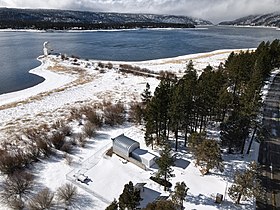| This article needs additional citations for verification. Please help improve this article by adding citations to reliable sources. Unsourced material may be challenged and removed. Find sources: "Synoptic Optical Long-term Investigations of the Sun" – news · newspapers · books · scholar · JSTOR (October 2020) (Learn how and when to remove this message) |
 SOLIS instruments at the National Solar Observatory (NSO)at Kitt Peak SOLIS instruments at the National Solar Observatory (NSO)at Kitt Peak | |
| Location(s) | Big Bear Solar Observatory, California |
|---|---|
| Coordinates | 34°15′38″N 116°55′15″W / 34.260547°N 116.920920°W / 34.260547; -116.920920 |
| Organization | NSO Integrated Synoptic Program (NISP) |
| Altitude | 2063.1 m |
| Built | 2003 |
| Website | solis |
| | |
| [edit on Wikidata] | |
Synoptic Optical Long-term Investigations of the Sun (SOLIS) is a synoptic facility for solar observations over a long time frame that is funded by the National Science Foundation (NSF) and designed and built by the National Solar Observatory (NSO). It is operated by the NSO Integrated Synoptic Program (NISP). SOLIS is a single set of three instruments mounted on a common observing platform. The instruments are the 50 cm aperture Vector Spectromagnetograph (VSM), the 8 mm aperture Integrated Sunlight Spectrometer (ISS), and the 14 cm aperture Full-Disk Patrol (FDP). The VSM telescope is a quasi-Ritchey-Chretien design with a primary mirror operating at f/1.6. The ~ 400 W of solar light from the primary is reflected by a secondary mirror fabricated from a single silicon crystal. The final f/6.6 full-disk solar image is focused on a spectrograph slit that is cooled by a flow of chilled water-propylene glycol solution. The mirrors are coated with protected silver. To improve the internal seeing, the VSM is sealed by 74 cm diameter, 6 mm thick fused silica window. Originally, it was filled with helium at about ambient pressure and temperature. In 2014, helium was replaced by nitrogen due to the increasing cost of helium. Due to this change, the image sharpness was slightly degraded.
The VSM provides full-disk vector (strength and direction) maps of the solar magnetic field both in the photosphere and in the chromosphere on a daily basis, continuing the 40-year record of NSO magnetic field observations. The ISS obtains spectra of the Sun integrated over the solar disk, so the Sun appears as it would as a much more distant star. The combination of data from the ISS and the VSM is useful for studies of exoplanet systems as it allows the modeling of the influence of a star's magnetic field on its spectrum giving clues to the activity level that the exoplanets may be subject to. The FDP provides full-disk images of the Sun in a variety of spectral lines with a cadence as high as 10 seconds.
SOLIS was located on top of the Vacuum Telescope building at Kitt Peak National Observatory until July 2014, then temporarily moved to the University of Arizona Agricultural Farm in Tucson until October 2017, and is now being permanently relocated to Big Bear Solar Observatory in California. Once back to operations, SOLIS will provide unique observations of the Sun on a continuing basis for several decades to understand the solar activity cycle, sudden energy releases in the solar atmosphere, and solar irradiance changes and their relationship to global change.
SOLIS Gallery
-
 Crews pour concrete footings, the first step in the construction of a permanent home of the NSF’s SOLIS instrument at Big Bear Solar Observatory in California
Crews pour concrete footings, the first step in the construction of a permanent home of the NSF’s SOLIS instrument at Big Bear Solar Observatory in California
-
 SOLIS on the shore of Big Bear Lake, California. White dome in the background is the Goode Solar Telescope
SOLIS on the shore of Big Bear Lake, California. White dome in the background is the Goode Solar Telescope
-
 SOLIS mount installation looking down
SOLIS mount installation looking down
-
 The vector spectromagnetograph mounted on top of the Kitt Peak Synoptic Optical Long-term Investigations of the Sun (SOLIS) Tower, formerly the vacuum telescope tower.
The vector spectromagnetograph mounted on top of the Kitt Peak Synoptic Optical Long-term Investigations of the Sun (SOLIS) Tower, formerly the vacuum telescope tower.
See also
References
- Keller, C. U.; Harvey, J. W.; Giampapa, M. S. (2003). Keil, Stephen L; Avakyan, Sergey V (eds.). "SOLIS: an innovative suite of synoptic instruments". Proceedings of the SPIE. Innovative Telescopes and Instrumentation for Solar Astrophysics. 4853: 194–204. Bibcode:2003SPIE.4853..194K. doi:10.1117/12.460373. S2CID 121871549.
- Balasubramaniam, K. S.; Pevtsov, A. A. (2011). Fineschi, Silvano; Fennelly, Judy (eds.). "Ground-based synoptic instrumentation for solar observations". Proceedings of the SPIE. Solar Physics and Space Weather Instrumentation IV. 8148: 194–204. Bibcode:2011SPIE.8148E..09B. doi:10.1117/12.892824. S2CID 123569040.
- National Research Council; Division on Engineering and Physical Sciences; Space Studies Board; Committee on Solar and Space Physics; Solar and Space Physics Survey Committee (17 December 2003). The Sun to the Earth - and Beyond: Panel Reports. National Academies Press. p. 26. ISBN 978-0-309-08972-2.
- Engvold, Oddbjorn; Vial, Jean-Claude; Skumanich, Andrew (15 November 2018). The Sun as a Guide to Stellar Physics. Elsevier. p. 422. ISBN 978-0-12-814335-3.
- Harvey, J. W. (2014). "Image Quality of SOLIS/VSM in Helium vs. Nitrogen". NSO Technical Report. NSO/NISP-2014-01: 1–10. arXiv:1405.7967.
- Leverington, David (2017). Observatories and telescopes of modern times : ground-based optical and radio astronomy facilities since 1945. New York: Cambridge University Press. p. 34. ISBN 978-0-521-89993-2. Retrieved 25 February 2023.
- Beal, Tom (2017-05-12). "Sun setting on solar telescope at Kitt Peak, southwest of Tucson". Arizona Daily Star. Retrieved 2020-10-19.
- "A new telescope expands Big Bear Solar Observatory's view of the Sun". phys.org/news/2018-06-telescope-big-solar-observatory-view.html. 28 June 2018. Retrieved 2020-10-19.
- "NSO/NISP: SOLIS Observational History". NSO/NISP: SOLIS Data Information. National Solar Observatory. 16 May 2018. Retrieved 2020-10-18.
- "NSF's National Solar Observatory breaks ground on new telescope site in California". NSO - National Solar Observatory. Retrieved 2021-09-12.